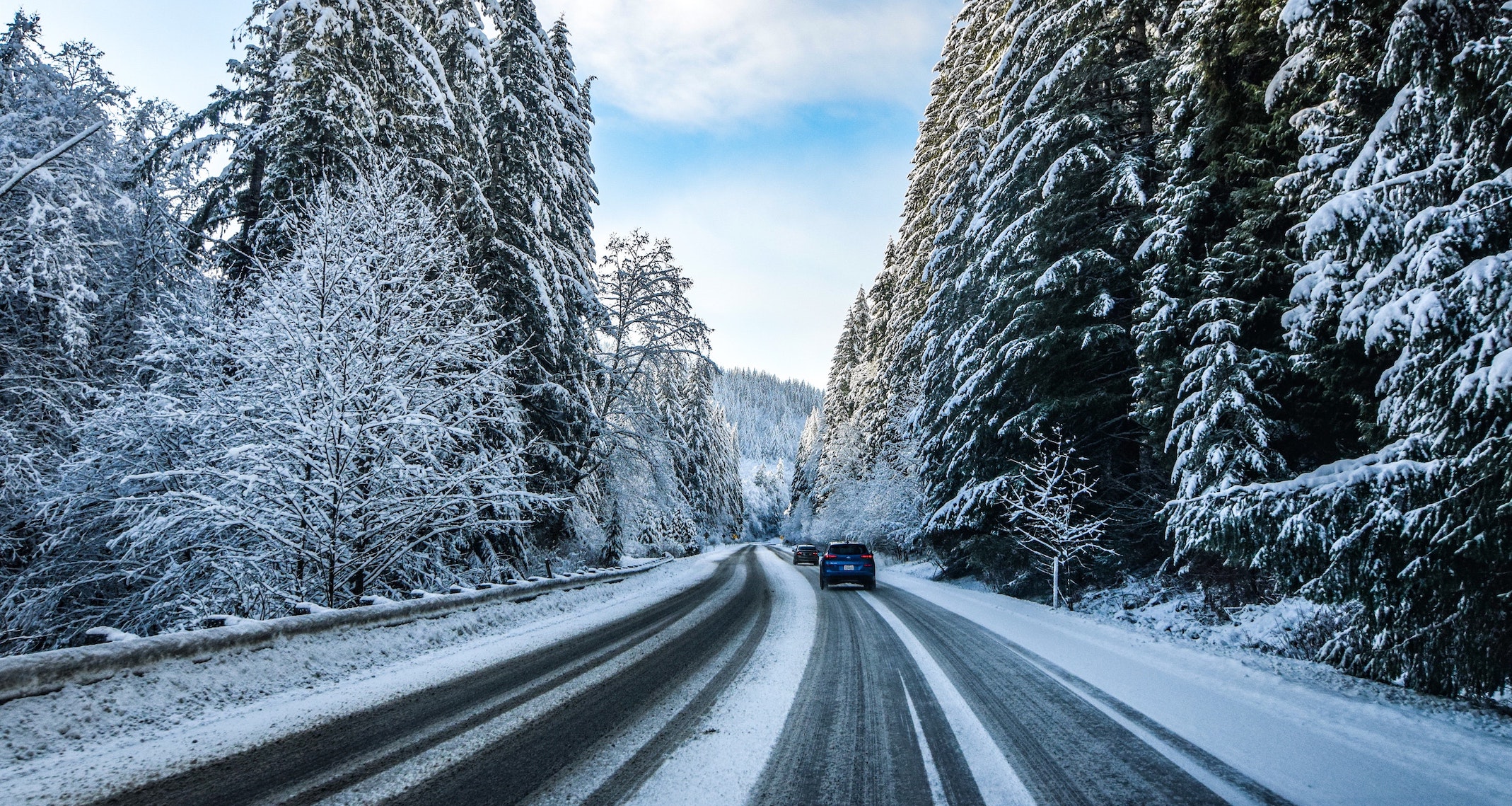
Dreaming of a socially distanced getaway, but chillier temps dampening your vagabond spirit? While a winter road trip requires more planning and preparation, a successful trip can be a welcome boost during the depths of winter.
Whether you’re driving to visit a national park, heading to the slopes, or temporarily relocating for a change of scenery, use these six tips to help you prepare for—and stay safe during—your winter road trip.
1. Prepare your vehicle for a winter road trip
Your first consideration for your winter road trip is your vehicle. If you own your car, consider getting it professionally serviced before your trip. If you’re renting a car, consult with the rental car agent to ensure all of the safety checks are up to date.
Here are some additional pre-trip checks:
- Tires: Check (and continue to monitor) the air pressure of your tires. Freezing temperatures cause tires to lose air quicker. You should also consider whether you will need snow tires for your road trip. Speak with a trusted mechanic ahead of your trip if you’re unsure of your tire needs.
- Fluid levels: Check (and monitor) the levels of your engine oil, antifreeze, power steering fluid, brake fluid, windshield wiper fluid, and transmission fluid before and during your winter road trip. Each of these essential fluids play a critical role in the safety of your vehicle.
- Gas tank: Keep your gas tank full in the week leading up to your trip. This will help avoid any water (in the form of condensation) collecting in and/or entering the fuel line which would stop the flow of gasoline. Keep this in mind when you reach your destination, as well. Depending on the temperature and how long your vehicle may sit idle for, you’ll want to mitigate any issues with the car starting when you’re ready to hit the road again.
Also, be sure to always clear all the snow from your car (not just the windshield) before you start to drive. When you clear just the windshield, snow from the roof may shift and slide forward. If this happens while you’re driving, your windshield wipers likely won’t be able to clear away thick and heavy snow. Avoid this safety hazard by fully clearing away all snow before driving. (More on what to pack for winter driving preparedness below.)
2. Forward your travel plans to TripIt
From car rental pickup to driving directions, TripIt can make sense of all your travel plans and create a single itinerary for your winter road trip. Simply forward your reservations to plans@ to create an itinerary in the app.
Once you’ve forwarded your travel plans to TripIt, you can also access a number of health and safety features, including:
- Nearby Places: Whether you’re looking for a place to eat, drink, or pick up supplies, TripIt’s Nearby Places feature makes it easy to find places along your winter road trip route (hint: you can search for places from any itinerary item with an address). Should you need medical help while traveling, Nearby Places also makes it easy to find hospitals, clinics, and pharmacies. If you find a place you want to visit but can’t get there right away, you can save it in TripIt to visit later. Find out more.>
- Neighborhood Safety Scores: To help you make safety-related decisions as you travel, and to better understand the areas in which you’re traveling, you can now set a personal risk level within the Neighborhood Safety Scores feature from TripIt. Then, the app will notify you if you’re planning on visiting an area that exceeds your safety threshold. The feature also includes a Health and Medical score that factors in COVID-19 data. Set your personal risk level.>
- COVID-19 Travel Guidance: TripIt shows you the latest COVID-19 travel guidelines, restrictions, and requirements—alongside infection rates—for the destinations you’re visiting along your road trip route. The COVID-19 travel guidance feature will help you stay as informed as possible, with the latest information all in one place, including entry requirements (like testing and quarantining), mask requirements, curfew orders, restrictions on dining and shopping, and more. Read more about the feature.>
- Inner Circle (Pro feature): Keep loved ones in the know about your road trip stops by sharing your travel plans to your Inner Circle. This Pro feature allows you to keep friends and family informed of your whereabouts in case they need to reach you. Not a Pro member? You can also share your travel plans in a variety of other ways (for free), including via text and email. More ways to share your plans.>
3. Research your winter road trip route
Planning your route in advance will help you identify areas prone for snow, ice, or slippery terrain. Look for routes that take you close to bodies of water (hint: they sometimes cause roads to become icy due to condensation/mist); paved roads versus dirt roads; as well as roads that are often not plowed and/or shut down during major storms. During the winter months, plan to stay on major roads as these are more often cleared of snow; avoid taking shortcuts in areas you’re not familiar with for this reason, as well.
If you’re traveling internationally, familiarize yourself with local road signs. Knowing the signs can alert you to upcoming, more treacherous terrain and road closures.
Finally, remember to always check the local weather forecast for your intended routes and destinations. If bad weather is expected, stay home until it’s deemed safe to travel.
Not ready to hit the road? Read our tips for planning a winter staycation.
4. Pack an emergency kit in case you get stuck—and know who to call for help
Although you probably had your car checked out before leaving, it’s best to anticipate the unexpected when you’re on the road—especially in inclement weather. Keep an emergency kit of cold-weather supplies in your car that is easily accessible, including items like:
- Extra food and water
- Warm clothing
- Flashlight and extra batteries
- Ice scraper
- Compact shovel
- Extra windshield wiper fluid
- Blankets
- Medications
- Portable phone charger
Before you leave on your winter road trip, download a roadside assistance app, such as the AAA app. With the AAA app, you can contact roadside assistance as well as help them locate you, should you need their help.
It’s also helpful to know the contact information for the local tow services in the areas you’ll be driving through—especially if it’s an international trip. Save these contact numbers in your phone so you don’t have to waste time looking them up.
5. Plan extra time to get to your road trip stops
If you’re planning several stops along your road trip, make sure your route is broken down into doable driving segments both to and from your final destination. As you plan a list of attractions you want to see along the way, incorporate extra driving time between stops in anticipation of inclement weather and/or unexpected detours.
Be sure to also research attractions’ hours and visitor guidelines. Reservations for attractions are likely to be required, so you may want to build in a buffer to make sure you get to your reservations on time.
Read more: 8 Cities That Embrace Winter
6. Book flexible accommodations
Building in extra time to reach your destination will help you to arrive on time for your reservations and check-in times, but once again, expect the unexpected on a winter road trip. If you aren’t able to arrive at your accommodations in time due to weather or road conditions, you’re going to want to know what your options are for checking in late and/or canceling your reservation.
When you’re booking overnight accommodations—whether it’s a hotel, vacation rental, or something else—look for flexible change and cancellation policies in case you need to modify your plans along the way.
If you’re planning to stay at a vacation rental, book a stay with contactless entry. Not only does this limit your exposure to others in the era of COVID, it will also allow you to enter your vacation rental regardless of the time you arrive and avoid any issue of the host being unable to meet you due to inclement weather, as well.

